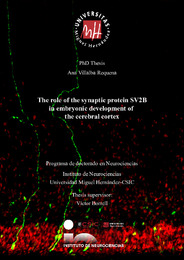Resumen :
The mammalian cerebral cortex experienced an extraordinary expansion during evolution, concomitant with an increase in complexity and cognitive capacities. The increase in cortical surface area appeared along with folding, which allowed including a large cortical surface within a limited cranial volume. This evolutionary process is recapitulated during embryonic development, where the activity of progenitor cells determines the final brain conformation. Apical Radial Glia Cells (aRGCs) are the main type of progenitor cells in the cerebral cortex, forming the Ventricular Zone (VZ). aRGCs give rise to Intermediate Progenitor Cells (IPCs) and basal Radial Glia Cells (bRGCs), that populate the Subventricular Zone (SVZ). In gyrencephalic species, with a folded cortex as ferrets or humans, the SVZ is dramatically enlarged and subdivided into inner and outer domains (ISVZ and OSVZ), densely populated by bRGCs and playing critical roles in cortex expansion and folding. In ferret, aRGCs switch from amplificative divisions to produce massive amounts of bRGCs during a brief period, which will establish the OSVZ. Disruptions in bRGC production profoundly impair OSVZ formation, altering normal folding. In the ferret VZ several genes change their expression levels during development, in parallel with the dynamics of aRGCs forming bRGCs and the emergence of the OSVZ. These genes are promising candidates to regulate this process and, therefore, cortical folding. One of these candidates is Sv2b, which encodes for the Synaptic Vesicle Glycoprotein 2B, with not known function in progenitor cells or cerebral cortex development. In this thesis, we show that in the small and smooth mouse cortex, with very few bRGCs, Sv2b is not expressed in germinal layers. In contrast, in the big and folded ferret brain Sv2b is highly expressed in germinal layers, dynamically changing its expression before, during and after the critical period for bRGCs generation. Sv2b is downregulated during the critical period and later on upregulated. Moreover, when bRGCs are being massively produced, Sv2b is more expressed in the SVZ than the VZ. We have found that SV2B accumulates in subcellular compartments of aRGCs, including varicosities of the processes and the end-feet. By gain- and loss-of-function experiments in mouse and ferret, we have found that SV2B is involved in the laminar organization of the VZ, the delamination of aRGCs to basal positions, and their proliferation. At mid-term, these alterations lead to folding of the cortex. Experimental overexpression of SV2B in ferret during the critical period, when endogenous Sv2b expression is low, causes a reduction in proliferation and neurogenesis. Conversely, Sv2b removal from aRGCs induces an increase in proliferation and basal mitoses. Thus, levels of Sv2b expression regulate the proliferative activity of aRGCs and the production of bRGCs during cerebral cortex development.
|
 La licencia se describe como: Atribución-NonComercial-NoDerivada 4.0 Internacional.
La licencia se describe como: Atribución-NonComercial-NoDerivada 4.0 Internacional.
.png)
